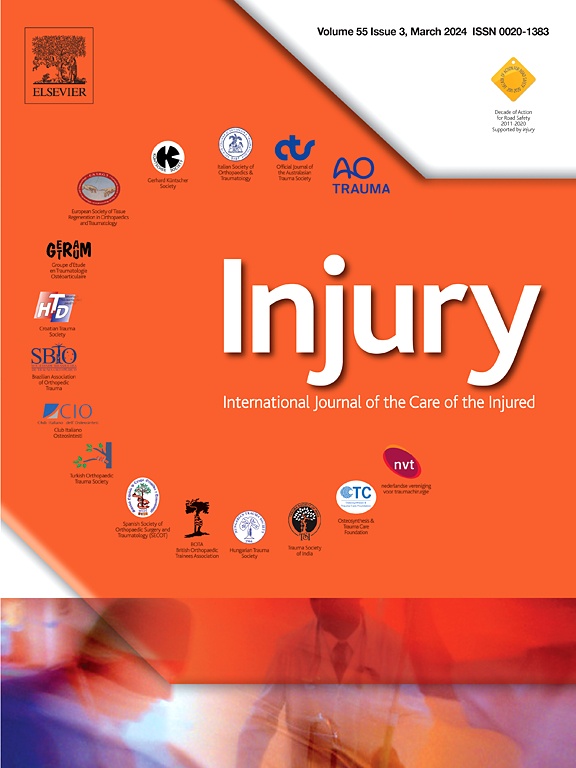
ORIF provides superior clinical outcomes for the treatment of impacted radial fractures

ORIF provides superior clinical outcomes for the treatment of impacted radial fractures
Treatment of complex fractures of the distal radius: a prospective randomised comparison of external fixation 'versus' locked volar plating
Injury. 2012 Feb;43(2):174-9. Epub 2011 Jun 25Did you know you're eligible to earn 0.5 CME credits for reading this report? Click Here
Synopsis
75 patients suffering from complex impacted distal radial fractures were randomized to open reduction and internal fixation (ORIF) or to an external fixation (EF) with constant traction to compare clinical and subjective results between these two fixation methods. At 6 month follow-up, the ORIF demonstrated superior clinical outcomes measured by the modified Green and O'Brien rating scale (based on clinical information, scale= 100-0). There were no differences in subjective scores between groups.
Was the allocation sequence adequately generated?
Was allocation adequately concealed?
Blinding Treatment Providers: Was knowledge of the allocated interventions adequately prevented?
Blinding Outcome Assessors: Was knowledge of the allocated interventions adequately prevented?
Blinding Patients: Was knowledge of the allocated interventions adequately prevented?
Was loss to follow-up (missing outcome data) infrequent?
Are reports of the study free of suggestion of selective outcome reporting?
Were outcomes objective, patient-important and assessed in a manner to limit bias (ie. duplicate assessors, Independent assessors)?
Was the sample size sufficiently large to assure a balance of prognosis and sufficiently large number of outcome events?
Was investigator expertise/experience with both treatment and control techniques likely the same (ie.were criteria for surgeon participation/expertise provided)?
Yes = 1
Uncertain = 0.5
Not Relevant = 0
No = 0
The Reporting Criteria Assessment evaluates the transparency with which authors report the methodological and trial characteristics of the trial within the publication. The assessment is divided into five categories which are presented below.
3/4
Randomization
3/4
Outcome Measurements
3/4
Inclusion / Exclusion
4/4
Therapy Description
2/4
Statistics
Detsky AS, Naylor CD, O'Rourke K, McGeer AJ, L'Abbé KA. J Clin Epidemiol. 1992;45:255-65
The Fragility Index is a tool that aids in the interpretation of significant findings, providing a measure of strength for a result. The Fragility Index represents the number of consecutive events that need to be added to a dichotomous outcome to make the finding no longer significant. A small number represents a weaker finding and a large number represents a stronger finding.
Why was this study needed now?
Fixation methods of complex radial fractures have yet to provide completely satisfactory results for patients, often resulting in a loss of radial length and articular issues. The traditional treatment of these fractures is external fixation with constant traction to maintain fixation. ORIF may provide superior results, when compared to EF, but due to the wide range of complex fractures there has yet to be a study comparing these two methods in the treatment of severely impacted fractures.
What was the principal research question?
Does open reduction and internal fixation provide superior clinical, radiological, and subjective outcomes when compared to external fixation with constant traction for the treatment of complex impacted distal radial fractures?
What were the important findings?
- There were no significant differences in terms of reduction results between the two groups
- 8 patients in each group had a loss of radial length >2 mm EF (20%), ORIF (22%)
- Green and O'Brien's rating were significantly better in the ORIF patients at 6 months (p<0.05) with 53% of patients having good to excellent ratings compared to 23% in the EF group
- Grip strength was greater in the ORIF group at 84% of the ipsilateral side compared to 76% in the EF group (p=0.02)
- A greater number of EF patients had a positive predictive score for Complex Regional Pain Syndrome (CRPS) at 6 week follow-up (p=0.03)
- There were no differences in patient-rated wrist evaluations between the two groups at the 6 month follow-up (p=0.98)
What should I remember most?
ORIF provided superior clinical outcomes, measured using the Green and O'Brien rating system, in-comparison to EF. However, there were no differences in subjective results between the two treatments. ORIF also provided greater grip strength for patient, which may be advantageous for young patients returning to regular and intense physical activity.
How will this affect the care of my patients?
ORIF appears to provide superior clinical outcomes and improved grip strength when compared to EF. This should be considered when treating young active patients who are seeking a quick and safe recovery to regular activity. Further research using large samples should be conducted to confirm these results.
Learn about our AI Driven
High Impact Search Feature
Our AI driven High Impact metric calculates the impact an article will have by considering both the publishing journal and the content of the article itself. Built using the latest advances in natural language processing, OE High Impact predicts an article’s future number of citations better than impact factor alone.
Continue



 LOGIN
LOGIN

Join the Conversation
Please Login or Join to leave comments.
Orthopaedic Surgeon - Canada
orif